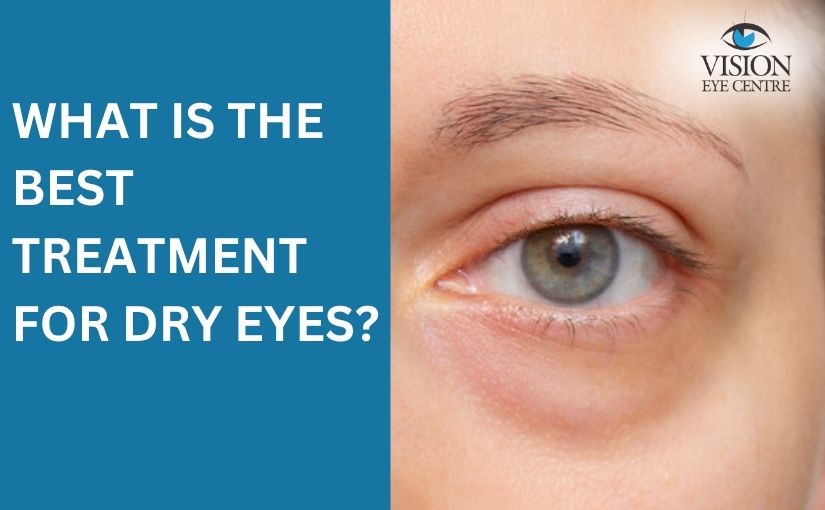
What is the Best Treatment for Dry Eyes?
Oct 28, 2025
Have your eyes been feeling dry, itchy, or irritated lately? You’re not alone. Millions of people across the world experience dry eyes at some point in their lives. In many cases, it’s a temporary issue caused by tiredness, dehydration, or screen use. But for some, dry eyes can become a chronic condition that affects daily comfort and vision clarity.
The key to finding the best treatment for dry eyes lies in understanding the cause — and then addressing it with the right medical care and lifestyle support.
At Vision Eye Centre, specialists provide comprehensive and advanced Dry Eye Treatment in Delhi, tailored to restore comfort, tear balance, and long-term eye health.
Understanding Dry Eyes
Dry eye syndrome, medically known as Keratoconjunctivitis Sicca, occurs when your eyes do not produce enough tears or when the tears evaporate too quickly. Tears play a crucial role in maintaining healthy eyes. They keep the surface moist, wash away debris, and protect against infection.
A healthy tear film has three layers:
-
Oil layer – Prevents tears from evaporating.
-
Water layer – Provides moisture and nourishment.
-
Mucus layer – Helps tears spread evenly over the eye.
When any of these layers are disrupted, your eyes can become dry, irritated, and inflamed.
Common Causes of Dry Eyes
Dry eyes can be caused by several factors. Understanding the underlying cause helps determine the best treatment for dry eye syndrome.
1. Age and Hormonal Changes
As we age, tear production naturally decreases. Hormonal changes during menopause can also lead to dryness, making dry eyes more common in women over 40.
2. Digital Screen Use
Blinking frequency decreases by up to 50% when looking at screens, causing tears to evaporate faster. This is why computer vision syndrome is a common cause of modern-day dry eyes.
3. Environmental Conditions
Air conditioning, wind, smoke, and dry climates can strip away the tear film, worsening dryness.
4. Medical Conditions
Autoimmune diseases like Sjögren’s syndrome, rheumatoid arthritis, thyroid disorders, and lupus are strongly linked to chronic dry eyes.
5. Medications
Certain medications like antihistamines, antidepressants, diuretics, and birth control pills may reduce tear production.
6. Contact Lens Use and Eye Surgery
Long-term contact lens wear or surgeries like LASIK can temporarily affect tear film stability, leading to dryness.
Symptoms of Dry Eyes
Dry eye symptoms can range from mild irritation to severe discomfort. Common signs include:
-
Burning or stinging sensation
-
Redness or itching
-
Blurred or fluctuating vision
-
Sensitivity to light
-
Feeling like something is in your eye (foreign body sensation)
-
Watery eyes (reflex tearing)
-
Difficulty wearing contact lenses
If left untreated, chronic dry eyes can lead to inflammation, corneal damage, and vision issues. That’s why timely diagnosis and professional Dry Eye Treatment in Delhi are essential.
Diagnosis of Dry Eye Syndrome
An ophthalmologist will conduct a detailed eye examination to identify the cause and severity of your dry eye condition. Diagnostic tests may include:
-
Tear Film Break-Up Time (TBUT): Measures how quickly tears evaporate.
-
Schirmer’s Test: Evaluates tear production using a small strip of paper placed under the eyelid.
-
Meibography: Assesses Meibomian gland function and oil layer quality.
-
Osmolarity Test: Checks tear composition and salt concentration.
Best Treatments for Dry Eyes
The goal of treatment is to restore tear film balance, relieve symptoms, and prevent long-term complications. Depending on the cause and severity, treatment options may include home remedies, medications, procedures, or advanced therapies.
Let's discuss the top 5 Treatments for Dry Eyes:
1. Artificial Tears and Lubricating Drops:
The first and most common treatment for dry eyes is the use of artificial tears or lubricating eye drops. These drops help moisten the eyes, relieve irritation, and restore comfort. For people with frequent symptoms, preservative-free or gel-based drops offer longer-lasting relief, especially at night.
2. Prescription Medications:
If over-the-counter drops aren’t enough, doctors may prescribe anti-inflammatory eye drops like cyclosporine (Restasis) or lifitegrast (Xiidra) to improve natural tear production. In some cases, short-term use of steroid eye drops and omega-3 supplements also helps reduce inflammation and enhance tear quality.
3. Warm Compresses and Eyelid Hygiene:
For dry eyes caused by Meibomian Gland Dysfunction (MGD), applying a warm compress to the eyelids helps open blocked oil glands, improving tear stability. Gentle eyelid massages and regular cleaning remove debris and bacteria, preventing gland blockage and irritation.
4. Punctal Plugs:
For chronic or severe dry eye, ophthalmologists may use tiny devices called punctal plugs to block the tear drainage ducts. This helps retain natural tears on the eye surface for a longer time, keeping the eyes moist and comfortable without surgery.
5. Advanced Therapies (LipiFlow & IPL):
For patients with persistent symptoms, advanced treatments like LipiFlow Thermal Pulsation and Intense Pulsed Light (IPL) Therapy provide lasting relief. These procedures improve the function of the oil glands, reduce inflammation, and restore the tear film.
Conclusion
Finding the best treatment for dry eyes involves understanding the underlying cause and adopting a personalised, multi-step approach. Mild cases may improve with artificial tears and lifestyle adjustments, while more severe or chronic conditions may require advanced procedures like LipiFlow, IPL therapy, or punctal plugs.
At Vision Eye Centre, experienced ophthalmologists provide comprehensive care using cutting-edge technology and patient-focused treatments to ensure long-term comfort and vision clarity. Whether you have mild dryness or severe dry eye syndrome, seeking professional help early is the key to lasting relief and healthier eyes.
Frequently Asked Questions
1. What is the best treatment for dry eyes?
The best treatment depends on the cause and severity. It may include artificial tears, warm compresses, prescription eye drops, or advanced therapies like IPL or LipiFlow for long-term relief.
2. Is dry eye curable permanently?
While chronic dry eye may not be permanently curable, proper treatment and lifestyle management can control symptoms effectively and prevent complications.
3. What is the best treatment for severe dry eyes?
For severe cases, treatments like LipiFlow Thermal Pulsation, Punctal Plugs, Autologous Serum Drops, or IPL Therapy are highly effective in restoring moisture balance.
4. Can dry eyes cause vision problems?
Yes. Chronic dry eyes can blur vision and make it difficult to focus, especially during reading or screen use. Timely treatment helps prevent corneal damage.
5. Can I use eye drops daily for dry eyes?
Yes, preservative-free artificial tears can be used multiple times a day. However, consult your eye doctor for suitable products and correct usage frequency.

